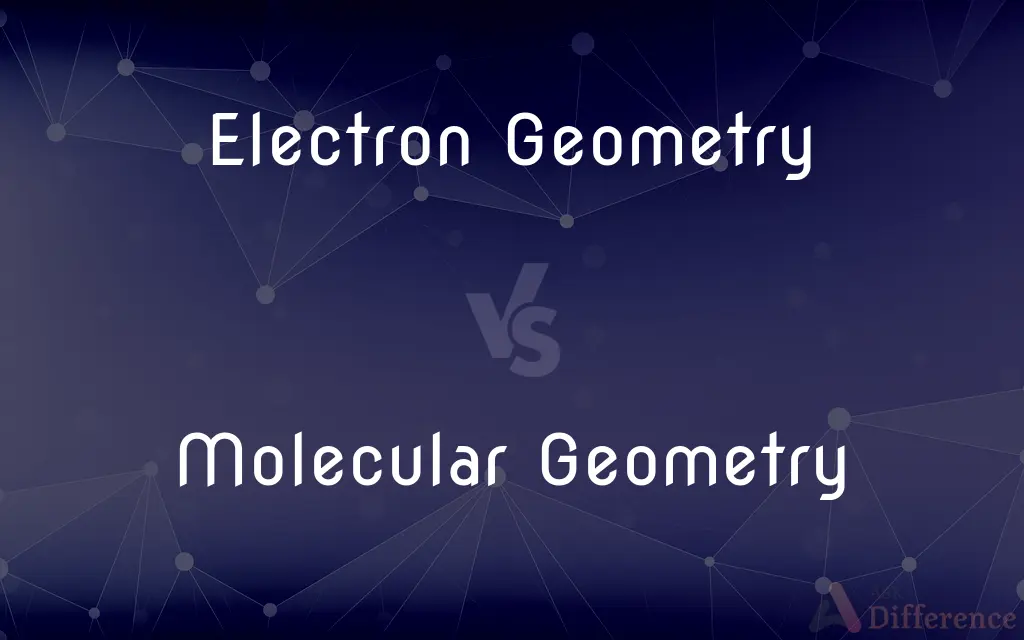Electron Geometry vs. Molecular Geometry — What's the Difference?
By Tayyaba Rehman — Published on October 24, 2023
Electron Geometry describes the spatial arrangement of all electron pairs around a central atom, while Molecular Geometry refers to the arrangement of only bonding atoms.

Difference Between Electron Geometry and Molecular Geometry
Table of Contents
ADVERTISEMENT
Key Differences
Electron Geometry takes into account both bonding and non-bonding electron pairs surrounding a central atom. This geometry gives a general spatial arrangement considering all forces acting on electron pairs, whether they are shared in bonds or exist as lone pairs. On the other hand, Molecular Geometry strictly relates to the orientation of bonding atoms in a molecule, focusing only on those atoms actually involved in bonds and not lone electron pairs.
While Electron Geometry serves as the foundation, giving an overarching spatial perspective, Molecular Geometry dives deeper into the actual shape the molecule takes in 3D space when non-bonding pairs are excluded. For example, if a molecule has a tetrahedral Electron Geometry due to four electron pairs, but one of these pairs is non-bonding, the Molecular Geometry would be described as trigonal pyramidal.
An interesting distinction lies in their outcomes: Electron Geometries tend to have more general descriptions like linear, trigonal planar, or tetrahedral, whereas Molecular Geometries can get specific like bent, see-saw, or T-shaped. This is because while Electron Geometry sets the stage based on total electron pairs, Molecular Geometry refines this based on where actual bonds occur.
Both Electron Geometry and Molecular Geometry are vital concepts in chemistry, particularly in the understanding of molecular shape and polarity. They help in predicting molecular behavior, reactivity, and the physical properties of compounds. But while Electron Geometry provides a broader overview, Molecular Geometry pinpoints the molecule's actual shape.
Comparison Chart
Definition
Arrangement of all electron pairs
Arrangement of only bonding atoms
ADVERTISEMENT
Considers
Bonding and non-bonding pairs
Only bonding pairs
Outcome
General shapes like tetrahedral, linear
Specific shapes like bent, trigonal pyramidal
Importance
Sets the stage for molecular shape
Determines actual 3D shape of molecule
Impact on molecule's properties
General influence on properties and reactivity
Direct influence on polarity, reactivity, and shape
Compare with Definitions
Electron Geometry
The orientation considering all electrons, bonding or not.
NH3 displays a tetrahedral Electron Geometry, including its lone pair.
Molecular Geometry
Actual shape considering only atom-to-atom connections.
Despite four electron pairs, the Molecular Geometry of SO2 is bent.
Electron Geometry
Arrangement of all pairs of electrons around a central atom.
In water, the Electron Geometry around the oxygen atom is tetrahedral.
Molecular Geometry
The 3D shape of a molecule excluding lone pairs.
Though based on a tetrahedral Electron Geometry, NH3 has a trigonal pyramidal Molecular Geometry.
Electron Geometry
The three-dimensional shape formed by all electron pairs.
The Electron Geometry of CH4 is tetrahedral due to four bonding pairs.
Molecular Geometry
The spatial configuration derived solely from bond angles.
CO2 exhibits a linear Molecular Geometry with O-C-O bond angle of 180°.
Electron Geometry
Layout determined by repulsions between electron pairs.
The Electron Geometry of BeCl2 is linear, having two bonding pairs and no lone pairs.
Molecular Geometry
Arrangement of atoms bonded to a central atom.
Water has a bent Molecular Geometry due to two hydrogen atoms.
Electron Geometry
Spatial configuration of both bonding and lone electron pairs.
With two bonding and two lone pairs, H2O has a tetrahedral Electron Geometry.
Molecular Geometry
Geometry arising from repulsions between bonded atoms.
BF3, with three bonded atoms and no lone pairs, has a trigonal planar Molecular Geometry.
Common Curiosities
Does Electron Geometry always match Molecular Geometry?
No, they can differ when there are lone pairs of electrons on the central atom.
Can a molecule have a linear Electron Geometry but bent Molecular Geometry?
Yes, like in H2O where the Electron Geometry is tetrahedral but the Molecular Geometry is bent.
Which determines the overall shape: Electron Geometry or Molecular Geometry?
Molecular Geometry gives the actual shape, while Electron Geometry provides an overarching spatial arrangement.
Does Electron Geometry take into account lone pairs?
Yes, it considers both bonding and non-bonding electron pairs.
Why is Molecular Geometry crucial in chemistry?
Molecular Geometry affects properties like polarity, reactivity, and intermolecular forces.
Do lone pairs affect Molecular Geometry?
Yes, they influence the shape by repelling bonding pairs, modifying bond angles.
Can two molecules have the same Electron Geometry but different Molecular Geometries?
Yes, for instance, CH4 and NH3 both have tetrahedral Electron Geometry but differ in Molecular Geometry.
Is it possible for a molecule to have the same Electron and Molecular Geometry?
Yes, in molecules without lone pairs on the central atom, like CH4.
Does Electron Geometry influence reactivity?
Indirectly, as it sets the foundation for Molecular Geometry which affects reactivity.
Which is more specific in terms of shape description?
Molecular Geometry, as it gives specific shapes like bent, T-shaped, etc.
Why is understanding both geometries vital?
Both offer insights into molecular behavior, reactivity, and physical properties.
Why is Electron Geometry broader than Molecular Geometry?
Because it includes all electron pairs, whereas Molecular Geometry only considers bonding pairs.
How does polarity relate to Molecular Geometry?
Molecules with non-symmetrical Molecular Geometries often have polar characteristics.
Are bond angles consistent within Electron Geometry?
No, bond angles can vary, especially when lone pairs are present.
What's a common Molecular Geometry for molecules with 3 bonds and no lone pairs?
Trigonal planar.
Share Your Discovery

Previous Comparison
Bank Guarantee vs. Solvency Certificate
Next Comparison
Horrid vs. MonstrousAuthor Spotlight
Written by
Tayyaba RehmanTayyaba Rehman is a distinguished writer, currently serving as a primary contributor to askdifference.com. As a researcher in semantics and etymology, Tayyaba's passion for the complexity of languages and their distinctions has found a perfect home on the platform. Tayyaba delves into the intricacies of language, distinguishing between commonly confused words and phrases, thereby providing clarity for readers worldwide.












































